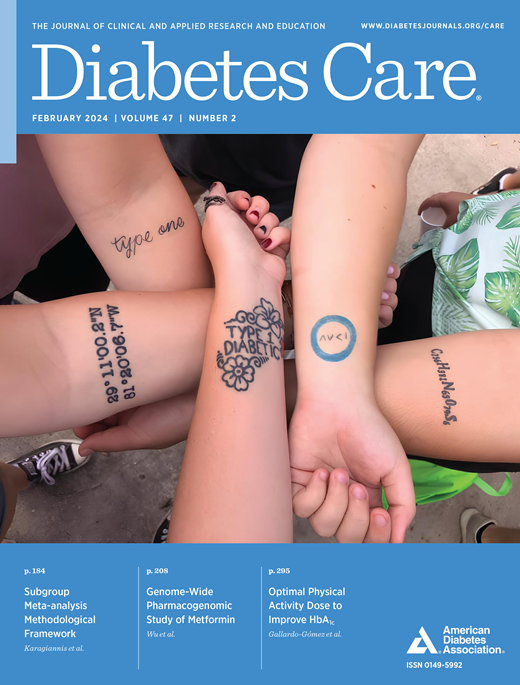妊娠期高血糖妇女产后再分类的1小时口服糖耐量试验
IF 16.6
1区 医学
Q1 ENDOCRINOLOGY & METABOLISM
引用次数: 0
摘要
目的:国际糖尿病联合会最近认可1小时口服葡萄糖耐量试验(OGTT)比传统的2小时OGTT更方便。在实践中,建议怀孕期间患有高血糖的妇女在分娩后6个月内进行2小时OGTT检查,但这项检查通常不会完成,部分原因是对忙碌的母亲不方便。认识到在这种情况下1小时OGTT的潜在优势,我们试图比较产后3个月1小时和2小时OGTT血糖测量作为产后前5年血糖异常(前驱糖尿病/糖尿病)的预测指标。研究设计和方法共有369名孕期糖耐量(从血糖正常到妊娠糖尿病[GDM])的女性在产后3个月、1年、3年和5年接受了多样本2小时75克ogtt治疗。通过Cox比例风险回归模型的一致性指数(CCI)的变化,将3个月OGTT的血糖测量列为血糖异常(两种标准)的预测因子。结果在3个月的OGTT中,70名同时被2小时血糖诊断为血糖异常的女性中,除10名外,其余均被1小时血糖诊断为血糖异常,另有96名女性被诊断为血糖异常。在3个月的OGTT中,血糖异常的累积发生率在5年内逐渐增加(P <;0.0001)。在回归分析中,血糖异常的最强预测因子是1小时葡萄糖(CCI变化:16.1%),其次是2小时葡萄糖(14.9%)。在患有GDM的女性中,1小时血糖再次成为血糖异常的最强预测因子(13.0%),其次是2小时血糖(12.8%)。结论:1小时OGTT可能为提高妊娠高血糖后的产后再分类率提供了一种策略。本文章由计算机程序翻译,如有差异,请以英文原文为准。
One-Hour Oral Glucose Tolerance Test for the Postpartum Reclassification of Women With Hyperglycemia in Pregnancy
OBJECTIVE The International Diabetes Federation recently endorsed a 1-h oral glucose tolerance test (OGTT) as more convenient than the conventional 2-h OGTT. In practice, women with hyperglycemia in pregnancy are advised to undergo a 2-h OGTT within 6 months after delivery, but this test is often not completed, partly owing to its inconvenience for busy mothers. Recognizing the potential advantage of the 1-h OGTT in this setting, we sought to compare 1-h and 2-h OGTT glucose measurements at 3 months postpartum as predictors of dysglycemia (prediabetes/diabetes) over the first 5 years postpartum. RESEARCH DESIGN AND METHODS A total of 369 women across a range of glucose tolerance in pregnancy (from normoglycemia to gestational diabetes [GDM]) underwent multisample 2-h 75-g OGTTs at 3 months, 1 year, 3 years, and 5 years postpartum. Glucose measurements from the 3-month OGTT were ranked as predictors of dysglycemia (both criteria) by change in concordance index (CCI) of Cox proportional hazard regression models. RESULTS At the 3-month OGTT, 1-h glucose identified all but 10 of 70 women concurrently diagnosed with dysglycemia by 2-h glucose, while diagnosing an additional 96 women. The cumulative incidence of dysglycemia progressively increased over 5 years by tertile of 1-h glucose on the 3-month OGTT (P < 0.0001). On regression analyses, the strongest predictor of dysglycemia was 1-h glucose (change in CCI: 16.1%), followed by 2-h glucose (14.9%). In women with GDM, 1-h glucose again emerged as strongest predictor of dysglycemia (13.0%), followed by 2-h glucose (12.8%). CONCLUSIONS The 1-h OGTT may offer a strategy for increasing rates of postpartum reclassification following hyperglycemia in pregnancy.
求助全文
通过发布文献求助,成功后即可免费获取论文全文。
去求助
来源期刊

Diabetes Care
医学-内分泌学与代谢
CiteScore
27.80
自引率
4.90%
发文量
449
审稿时长
1 months
期刊介绍:
The journal's overarching mission can be captured by the simple word "Care," reflecting its commitment to enhancing patient well-being. Diabetes Care aims to support better patient care by addressing the comprehensive needs of healthcare professionals dedicated to managing diabetes.
Diabetes Care serves as a valuable resource for healthcare practitioners, aiming to advance knowledge, foster research, and improve diabetes management. The journal publishes original research across various categories, including Clinical Care, Education, Nutrition, Psychosocial Research, Epidemiology, Health Services Research, Emerging Treatments and Technologies, Pathophysiology, Complications, and Cardiovascular and Metabolic Risk. Additionally, Diabetes Care features ADA statements, consensus reports, review articles, letters to the editor, and health/medical news, appealing to a diverse audience of physicians, researchers, psychologists, educators, and other healthcare professionals.
 求助内容:
求助内容: 应助结果提醒方式:
应助结果提醒方式:


